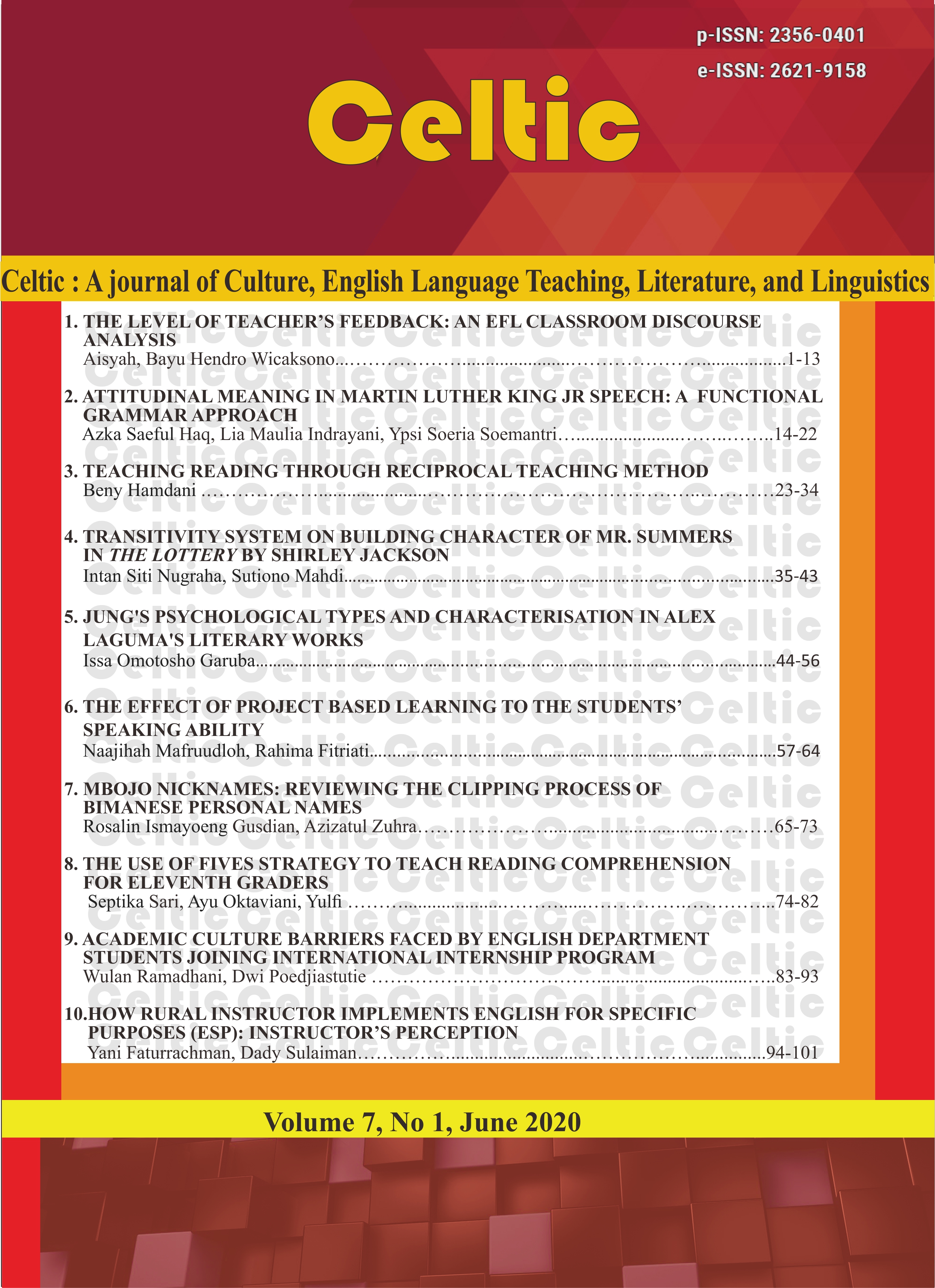TEACHING READING THROUGH RECIPROCAL TEACHING METHOD
DOI:
https://doi.org/10.22219/celtic.v7i1.11936Keywords:
Effectiveness, Reading Comprehension, Reciprocal Teaching MethodAbstract
This paper aims to investigate whether the university students who are taught reading through Reciprocal Teaching Method achieve better in reading ability than those who are taught through Direct Reading Thinking Activities. The design of this study is a quasi-experimental, non-randomized control group, pretest-posttest since it is conducted in a classroom setting that the subjects have been organized into classes. The subject of the study was the fourth term of university students of English education study program consisting 30 university students. The instrument of this research was a test as Pre-test and Post-test in the form of reading comprehension questions. The data analysis used Independent T-Test. Based on the result of the calculation of post-test from experimental and control groups, the alternative hypothesis (Ha) was accepted. The result of the study shows that the use of the Reciprocal Teaching Method can improve the university students’ reading ability. It proves the hypothesis of the study that students who are taught reading through the Reciprocal Teaching method achieve better in reading ability than those who are taught through Direct Reading Thinking Activities. Based on this result, it can be concluded that the Reciprocal Teaching Method can be used as an alternative method to teach reading, so that the students are able to understand the texts comprehensively. It also makes the university students more active in the teaching learning process and can improve their ability as well.
Downloads
References
Anderson, N. 1999. Exploring Second Langugae Reading. Canada:Heinle&Heinle Publishers.
Ary,D.,et al. 2010. Introduction to Research in Education. (8th Ed). USA : Wadswort Publishing Company.
Choo, T.O.L.,Eng, K.T, and Ahmad, N. 2011. Effects of Reciprocal Teaching Strategies on Reading Comprehension. The Reading Matrix, Vol. 11 (2). 149-150.
Cooper, T. and Greive, C. 2009. The effectiveness of the methods of Reciprocal Teaching, As applied within the NSW Primary Subject Human Society and its Environment: An Exploratory Study. Education Papers and Journal Articles. Vol. 3 (1), 45-52.
Diah Retno Widowati, Kurniasih Kurniasih. 2018. Critical Reading Skill And Its Implication To Speaking Ability In Multicultural Classroom. A journal of culture, English Language Teaching, Literature and Linguistics (CELTIC). Vol 5, No 2 (2018) DOI :10.22219/celtic.v5i2.7618
Doolittle, P.E.,Hicks, D.,Triplett, C.F.,Nicholas, W.D.,and Young.,C.A. 2006. Reciprocal Teaching for Reading Comprehension in Higher Education: A Stategy for fostering the deeper understandingof texts. International Journal of teaching and learning in Higher Education. Vol. 17 (2), 106-118.
Harris, K.R. and Graham, S. (Eds.).2007. Teaching Reading Comprehension to students with learning difficulties. New York: The Guilford Press.
Harun, Ali. 2015. The effect of using DRTA strategy on reading comprehension across students’ personality. Unpublished Thesis:Graduate Program State University of Malang.
Hedgock, J.S & Ferris, D.R. 2009. Teaching Readers of English: Students, Texts, and Contents. New York : Routledge.
Indrayani, N.,2005. The Implementation of Reciprocal Teaching Method for the Teaching of ESP at the Biology Department of the State University of Malang. Unpublished Thesis Malang:Graduate Program State University of Malang.
Roe, B.,Smith, S.H.,and Burns, P.C.2012. Teaching Reading in Today’s Elementary Schools (What’s news in Education) 11 th Edition. Wadsword:Cengage Learning.
Saraswati Ayudiah and Sumarsono P. 2014. The use of Mind-mapping to improve students’ reading comprehension at SMAN 1 Grati Pasuruan. A journal of culture, English Language Teaching, Literature and Linguistics (CELTIC). Vol 1, No 2 (2014): November 2014. DOI: 10.22219/celtic.v1i2.4666
Stahl, K.A. 2008. The effect of three instructional methods on the reading comprehension and content acquisition of Novice Readers. Journal of Literacy Research, 359-393.
Sulistyo, G.H.2011. Reading for Meaning, Theories, Teaching Strategies, and Assessment. Malang: Pustaka Kaiswaran.
Suryanto.,B. 2010. Implementing Recirpocal Teaching Method to Improve The Reading Comprehension Ability of the Eleventh Graders of MAN Muara Teweh, Central Kalimantan. Malang : Unpublished Thesis Graduate School State University of Malang.
Zakiya. L.,F. 2008. Improving Reading Comprehension on the Fourth Semester English Students of Islamic University of Malang Using Reciprocal Teaching. Unpublished Thesis. Malang: State University of Malang in Graduate Program in English Language Education.
Downloads
Published
How to Cite
Issue
Section
License
- Authors retain copyright to publish without restrictions and grant the journal right of first publication with the work simultaneously licensed under a Creative Commons Attribution License that allows others to share the work with an acknowledgement of the work's authorship and initial publication in this journal.
- Authors are able to enter into separate, additional contractual arrangements for the non-exclusive distribution of the journal's published version of the work (e.g., post it to an institutional repository or publish it in a book), with an acknowledgement of its initial publication in this journal.
- Authors are permitted and encouraged to post their work online (e.g., in institutional repositories or on their website) prior to and during the submission process, as it can lead to productive exchanges, as well as earlier and greater citation of published work.














